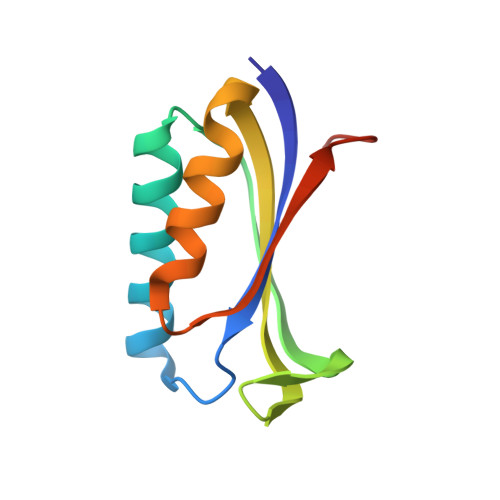Antagonism, Non-Native Interactions and Non-Two-State Folding in S6 Revealed by Double-Mutant Cycle Analysis.
Otzen, D.E.(2005) Protein Eng Des Sel 18: 547
- PubMed: 16230299
- DOI: https://doi.org/10.1093/protein/gzi063
- Primary Citation of Related Structures:
2BVZ, 2BXJ - PubMed Abstract:
When folding to the native state N in the presence of salt, the apparent two-state folder S6 transiently forms a transient off-pathway state C with substantial secondary and tertiary structure. Fifteen double mutant cycles were analysed to compare side-chain interaction energies DeltaDeltaG(int) in C, N and TS (the transition state between N and the denatured state). The kinetic signatures of these destabilizing mutants suggest folding scenarios involving unfolding intermediates and even alternative unfolding pathways. However, restricting the kinetic data to linear parts of the chevron plot allows reliable extrapolation to zero molar denaturant of rate constants of folding, unfolding and misfolding. Side-chain interactions appear to contribute to the stability of C, but in a substantially non-native environment, as shown by changes in the sign of DeltaDeltaG(int) between C and N. Remarkably, there appear to be significant (0.7-2 kcal/mol) antagonistic interactions between the two residues Leu30 and Leu75 in N and TS, which may be linked to subtle structural changes seen in the crystal structures of the mutants. A small number of overlapping residues are involved in these kinds of antagonistic interactions in N, TS and C, suggesting that repulsive interactions are coded into the protein topology whether the protein folds or misfolds. Destabilizing double mutants indicate that apparent two-state folders can be induced to behave in more complex ways provided that the native state is suitably destabilized.
Organizational Affiliation:
Department of Life Sciences, Aalborg University, Sohngaardsholmsvej 49, DK-9000 Aalborg, Denmark. dao@bio.aau.dk














